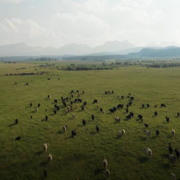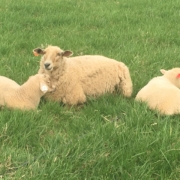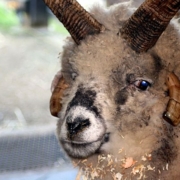The Season of Mud
 Print This Post
Print This Post
By Tammy Barnes, NCAT Agriculture Specialist
Ah, the season of boot-sucking, tractor sliding, truck bed smashing, brown paw-printed kitchen floors, heavy pant cuffs, human swearing mud. The constant freeze-thaw cycles of the eastern part of the U.S. create ankle-busting holes and ruts that are maddening and dangerous to humans and beasts. Our pastures are devastated by livestock feeding areas, hooves, gate ruts, excessive rain, snow melt, and lack of vegetative cover during the non-growing season.
We are too aware of the cost of pasture forage restoration, truck fenders, and loss of man hours, but there is also a cost to the health and welfare of our livestock. This expense is seen in vet bills, wasted feed, animal stress, and decreased feed efficiency. The challenges associated with mud on livestock farms, particularly cattle and horse farms, need to be addressed because their health affects production goals. Not to mention that no livestock owner wants to see their animals covered in mud and manure.
Let’s examine how mud affects cattle and horses, as they often create muddy conditions.
- Mud-coated hair, especially in chilling wet conditions, decreases the ability of the hair coat to insulate the body during cold weather. The lack of body insulation will increase the basal energy needs of the animal. Therefore, more feed is needed to keep the body warm, and they will lose weight if more forage and supplemental feed are not provided. A 1,200-pound cow standing shin deep in mud will require an extra 4.2 pounds of feed per day.
|
Mud Depth |
Potential Loss or Gain, 21°F to 39°F |
|
Dew Claw |
+7% |
|
Shin |
+14% |
| Hock |
+28% |
Source: How Feeding-Site Mud and Temperature Affect Animal Performance. Kansas State University Extension.
- Foot rot is more common in wet, boggy conditions. Foot rot is an infection of the hoof and causes severe inflammation. Bacteria that cause it lives in the mud and if there is a break in the skin, infection can occur. Standing in wet areas makes the skin softer and more likely to get cuts and nicks.
- Calves born in a muddy environment have trouble keeping warm and are more likely to get scours. Mud and manure harbor harmful bacteria and other pathogens. When the newborn calf nurses a dirty udder, they ingest the harmful bacteria at a time when their gut pores are large enough to allow pathogenic bacteria into the blood stream. Ingesting them before colostrum can cause deadly scours from clostridial bacteria or E. coli.
- Calves born in a muddy environment can get navel ill. Bacteria gets into the navel and can create abscesses, sepsis, or joint ill.
- Small calves can get stuck in the mud and trampled in boggy areas around hay rings and feeding areas.
- Horses will get mud fever on the pasterns and rain rot from being turned out in mud. Mud fever can be hard to treat if it takes hold and can produce swelling on the cannon bone and lameness. Rain rot is also hard to treat if the condition persists.
- Lost horseshoes and soft hooves are a common problem. Foot abscesses and the resulting lameness are common in horses with soft feet.
Mud Mitigation
- Mud is a challenge on any farm and all the best efforts will not prevent it from happening. We can’t escape the season of mud, but there are some management strategies that can help minimize the number of impacted acres.
- A heavy-use area or sacrificial pen with good drainage can be used to feed and water animals when the weather is wet and when pastures are susceptible to foot divots or pugs, and soil is very wet. Mud in the winter will result in soil compaction later. Remember that this area must have enough space to hold the animals comfortably without overcrowding.
- Restricting animals from poorly drained areas, such as creek sides or in flat areas below a hill side during wet weather.
- Do not feed hay near creeks or downhill from a slope.
- Move hay rings and feeders when it starts to get muddy around them. Consider unrolling hay bales when conditions permit, this will prevent soil compaction and loss of forage.
- Scrape or clean heavy-use areas often. It may be necessary to add some bedding to pens.
Related ATTRA Resources:
Pasture, Rangeland, and Adaptive Grazing
Other Resources:
Muddy Feedlot Surfaces: What Are My Options?

Photo: Tammy Barnes, NCAT
This blog is produced by the National Center for Appropriate Technology through the ATTRA Sustainable Agriculture program, under a cooperative agreement with USDA Rural Development. ATTRA.NCAT.ORG.





 Lynn Betts, NRCS/SWCS
Lynn Betts, NRCS/SWCS


 Jean Ogdon/ Creative Commons
Jean Ogdon/ Creative Commons

